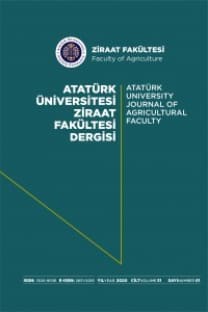Bant İlaçlaması ve Direkt İlaçlama Yapan Üniteler ve Kullanım Alanları
Dünya nüfusunun hızla artışı, tarımsal üretimde verim artışını gerektirmektedir. Birim alandan daha fazla ve kaliteli ürün alabilmek tüm üretim girdileri ve tekniklerinin kullanılması ile mümkün olmaktadır. Bu üretim girdileri içerisinde çok önemli bir yer tutan tarımsal mücadele elde edilen ürünün garantisini artıran bir üretim girdisidir. Tarımsal mücadele içerisinde uygulama kolaylığı ve etkisinin kısa zamanda görülmesi nedeniyle kimyasal mücadele yöntemi diğerlerine tercih edilmektedir. Bu çalışmada kimyasal mücadelede kullanılan yöntemler içerisinde yer alan bant ilaçlaması ve direkt ilaçlama yöntemleri ve bu yöntemlerin kullanım alanları ortaya konulmaya çalışılmıştır.
Anahtar Kelimeler:
İlaçlama, bant ilaçlaması, direkt ilaçlama
___
- Akın, P.P., 2004. Pestisit kalıntılarının insan sağlığı üzerine etkisi. Konya Tarım Gazetesi ISSN: 1303–0116. Yıl:20/sayı:220.
- Aksoy, H., Bayat, A., 1991. Micromax tip döner diskli memeye ait işletme karekteristikleri ve ilaç uygulama etkinliğinin saptanması. 6. Uluslararası Tarımsal Mekanizasyon ve Enerji Kongresi. 2–6 Eylül, Ankara.
- Anonymous., 2005. ASAE Standarts 327.2 FEB03. Terminology and definitions for agricultural chemical application. Canyurt, M. A., 1983. Zirai mücadele ilaçlarının su ürünleri üzerine etkileri ve alınması gereken önlemler. Tarım ve Mühendislik Dergisi, sayı:12–13, s.39
- Coates, W., 1996. Spraying tecnologies for cotton deposition and efficacy. Applied Engineering in Agriculture, 12 (3), 287– 296.
- Çelik, N., 2000. Tarımda girdi kullanımı ve verimliliğe etkileri uzmanlık tezi. İktisadi Sektörler ve Koordinasyon Genel Müdürlüğü Tarım Dairesi, Temmuz 2000.
- Çilingir, İ., Dursun, E., 2002. Bitki koruma makinaları. Ankara Üniversitesi Tarım Makinaları Bölümü, 248, Ankara.
- Daniel, H., Edward, C.P., Toller, J.M., 1992. Cost efficient weed control in soybean (Glycine max) with cultivation and banded herbicide applications. Weed Technol. 6, 990–995.
- Daum, D. R., Jurchak T.B., 2001. Save with band spraying. PENNSTATE College Of Agricultural Sciences Agricultural and Biological Engineering B-3.
- Eadie, A.G., Swanton, C.J., Shaw, J.E., Anderson, G.W., 1992. Banded herbicide applications and cultivation in a modified no-till corn system. Weed Technol. 6, 535–542.
- Gorneau, W.S., Franti, T.G., Benham, B.L., Comfort, S.D., 2001. Reducing long-term atrazine run-off from south central Nebraska. Transactions of the ASAE, California-USA 44, 45–52.
- Grisso, R., Dickey, E., Martin, A., 1991. Set up of tillage, planting and direct spray equipment. NebGuide G91–1019.
- Grisso, R., Ozkan, H.E., Hofman, V., Womac, A., Wolf, R., Hoffman, W.C., Williford, J., Valco, T., 2000. Pesticide application equipmant. Chapter 29.
- Hansen, N.C., Gupta, S.C., Moncrief, J.F., 2000. Herbicide banding and tillage effects on run-off, sediment and phosphorus losses. J. Environ. Qual. 29, 1555–1560.
- Heydel, L., Benoit, M., Schiavon, M., 1999. Reducing atrazine leaching by integrating reduced herbicide use with mechanical weeding in corn (Zea mays). Eur. J. Agronom. 11, 217–225.
- Hofman, V., 1991. Penetration of spray into sugarbeet plants. Sugarbeet Research and Extension Reports, 22, 60–64. Illiev, I.I., 2004. Precizion band spraying of sunflower. Res. Common of U.S.B. Branch Dobrich, Vol 6(1), 104–109.
- Kan, M., Gün, S., 2000. Türkiye’ de tarım ilaçlarının kullanımı ile ilgili yasal düzenlemeler ve kurumsal yapı. Türk- Koop. Ekin Dergisi, 14 (4), 28–34.
- Manson, B., 1983. Cheaper weed control, is it possible? Betodlaren Sweden 46 (1), 49–50 (CABPEST CD, 1973– 1988).
- Matthews, G. A.,1979. Pesticide Application Methods. Longman, p.1–325.
- Moomaw, R.S., Robison, L.R., 1973. Broadcast or banded atrazine plus propachlor with tillage variables in corn. Weed Sci. 21, 106–109.
- Parish, R.L., Reynolds, D.B., Crawford, S.H., 1995. Precisionguided cultivation techniques to reduce herbicide inputs in cotton. Appl.Eng. Agric. 11, 349–353.
- Prueger, J.H., Hatfield, J.L., Sauer, T.J., 1999. Field-scale metolachlor volatization flux estimates from broadcast and banded application methods in central Iowa. J. Environ. Qual. 28, 75–81.
- Ryley, M. J., Kyei, N. A., J. Tatnell., 2000, Evaluation of fungicides for the management of sclerotinia blight of peanut. Aust. J. Agric. Research, 51, 917–924
- Sankula, S., VanGessel, M.J., Kee, W.E., Beste, C.E., Kee, Everts Jr., 2001. Narrow row spacing does not affect lima bean yield or management of weeds and other pests. Hort Science. 36, 884–888.
- Shock, C.S., Seddigh, M., Hobson, J.H., Tinsley, I.J., Shock, B.M., Durand, L.R., 1998. Reducing DCPA losses in furrow irrigation by herbicide banding and straw mulching. Agron. J. 90, 399–404.
- Sumner, H. R., Herzog, G. A., 2000. Assessing the effectiveness of air-assisted and hydraulic sprayers in cotton via leaf bioassay. The Journal of Cotton Science, 4, 79–83.
- Sumner, H. R., Herzog, G. A., Sumner, P. E., Bader, M., Mullinix, B. G., 2000. Chemical application equipment for improved deposition in cotton. The Journal of Cotton Science, 4, 19– 27.
- Swanton, C.J., Weise, S.F., 1991. Integrated weed management: the rationale and approach. Weed Technol. 5, 657–663.
- Turabi, M.S.,2004. T.C.Tarım ve Köyişleri Bakanlığı Koruma ve Kontrol Genel Müdürlüğü.
- Üremiş, İ., Bayat A., Uludağ., A., Bozdoğan, N., Aksoy E., Aksoy. E., Soysal. A., Gönen. O., 2004. Studies of different herbicide application methods in second-crop maize fields. Crop Protection, 23, 1137–1144.
- Womac, A. R., Mulrooney, J. E., Scott, W. P, 1992. Characteristics of air-assisted and drop-nozzle sprays in cotton. Transactions of the ASAE, 35 (5), 1369–1376.
- Womac, A., Wills, J., Ellis, L., Coffey, D., 2002. İmproving drop nozzle and air blast tomato spraying. http://bioenngr.ag.utk.edu/Extension/extprog/vegetable/year/ vegınıtreport00/60
- Womac, A., Smith, CW., Mulrooney, JE., 2004. Foliar spray banding characteristics. Transacions of the ASAE, 47(1), 37– 44.
- Yağcıoğlu, A., 1993. Bitki koruma makinaları. Ege üniversitesi Ziraat Fakültesi Yayın No: 508, 338s. Bornova, İzmir.
- Yıldırım, E., 2000. Tarımsal zararlılarla mücadele yöntemlerinde kullanılan ilaçlar. Atatürk Üniversitesi Ziraat Fakültesi Yayınları No: 219, Erzurum
- ISSN: 1300-9036
- Yayın Aralığı: Yılda 3 Sayı
- Yayıncı: AVES Yayıncılık
Sayıdaki Diğer Makaleler
Genetik Karakterizasyonda Mitokondriyal DNA Kullanımı
Erzurum Kentinde Konut Bahçelerinin Peyzaj Tasarım İlkelerine Göre İncelenmesi Üzerine Bir Araştırma
Yıldıran YILDIRIM, İsmail ÖZTÜRK
Siyah Alaca Sığırlarda Gebelik Başına Tohumlama Sayısı Üzerine Etkili Faktörlerin Analizi
Et ve Et Ürünlerinde Heterosiklik Aromatik Amin Oluşumunun Engellenmesi
